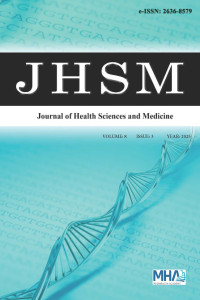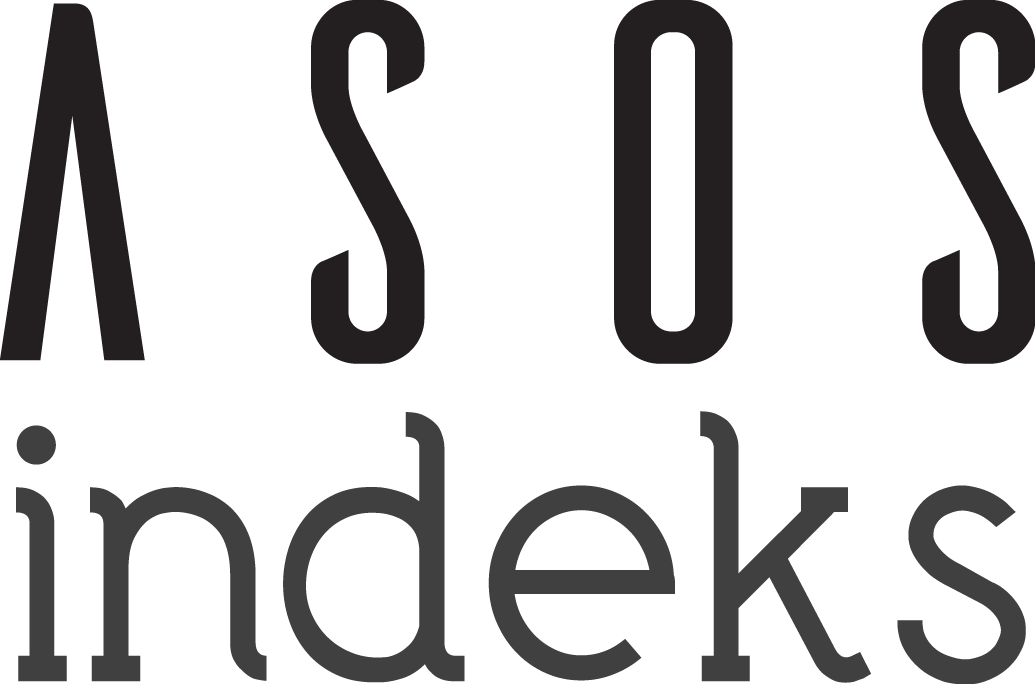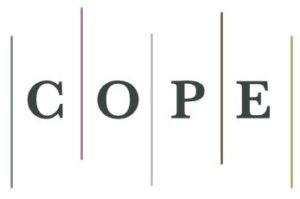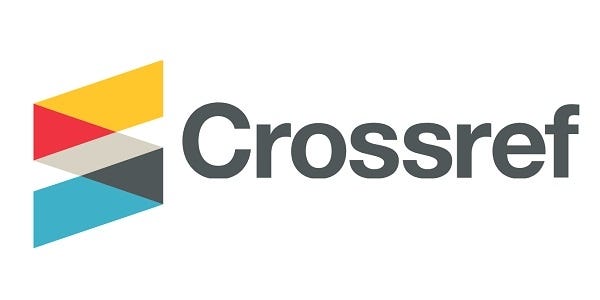Abstract
Amaç:
Kronik obstrüktif akciğer hastalığı (KOAH), hava akımı kısıtlanması ve kronik hava yolu inflamasyonu ile karakterize ilerleyici bir solunum hastalığıdır. KOAH hastalarının tedavi ve prognozunu daha iyi belirleyebilmek adına çeşitli biyobelirteçler araştırılmıştır ve bu biyobelirteçler arasında kan eozinofil düzeyleri dikkat çekmektedir. Bu çalışmada, KOAH alevlenmelerinde kan eozinofil düzeyleri ile klinik sonuçlar arasındaki ilişkinin değerlendirilmesi amaçlanmıştır.
Yöntem:
Yoğun bakım ünitesine (YBÜ) bir yıllık süre içerisinde kabul edilen 141 KOAH hastasına ait veriler retrospektif olarak analiz edilmiştir. Hastalar kan eozinofil düzeylerine göre iki gruba ayrılmıştır: düşük (0–100 hücre/µL) ve orta-yüksek (>100 hücre/µL) eozinofil grubu. Bu gruplar klinik skorlama sistemleri, laboratuar bulguları ve yoğun bakımdaki klinik sonlanımlarına göre karşılaştırılmıştır.
Bulgular:
Düşük eozinofil düzeyine sahip hastalarda prokalsitonin, nötrofil/lenfosit oranı (NLR) ve trombosit/lenfosit oranı (PLR) gibi enfeksiyon belirteçlerinin daha yüksek olduğu saptanmıştır. Ayrıca, eozinofil düzeyindeki artış ile parsiyel karbondioksit basıncı (pCO₂) arasında zayıf pozitif bir korelasyon gözlenmiştir. Bununla birlikte, kan eozinofil düzeyleri ile mortalite, trakeostomi gereksinimi veya inotropik destek ihtiyacı gibi sonuçlar arasında anlamlı bir ilişki bulunmamıştır.
Sonuç:
Kortikosteroidlere yanıt öngörüsündeki rolünün yanı sıra, kan eozinofil sayısı yoğun bakımda yönetilen KOAH alevlenmelerinde tedavi yaklaşımlarını yönlendirmede ve prognozu öngörmede potansiyel bir biyobelirteç olarak değerlendirilebilir. Eozinofil düzeyleri yüksek, yoğun bakımda takip gerektiren KOAH hastalarının non-enfeksiyöz atakların daha ön planda olduğu göz önünde bulundurulmalıdır.
Ethical Statement
Çalışma Helsinki Deklarasyonu’na uygun olarak gerçekleştirilmiş ve Ankara Sanatoryum Eğitim ve Araştırma Hastanesi Klinik Araştırmalar Etik Kurulu tarafından onay alınarak yapılmıştır (tarih: 11.12.2024, karar no: 2024-BÇEK 185).
Supporting Institution
yok
Thanks
yok
References
- Global initiative for chronic obstructive lung disease (GOLD). Global strategy for the diagnosis, management, and prevention of chronic obstructive pulmonary disease (2023 report). Available from: https://goldcopd.org. Accessed 2024 Nov 4.
- Vogelmeier CF, Criner GJ, Martinez FJ, et al. Global strategy for the diagnosis, management, and prevention of chronic obstructive lung disease 2017 report. GOLD executive summary. Am J Respir Crit Care Med. 2017;195(5):557-582. doi:10.1164/rccm.201701-0218PP
- Bafadhel M, McKenna S, Terry S, et al. Blood eosinophils to guide corticosteroid treatment of exacerbations of chronic obstructive pulmonary disease: a randomized placebo-controlled trial. Am J Respir Crit Care Med. 2012;186(1):48-55. doi:10.1164/rccm.201108-1553OC
- Vedel-Krogh S, Nielsen SF, Lange P, Nordestgaard BG. Blood eosinophils and exacerbations in chronic obstructive pulmonary disease: the Copenhagen general population study. Am J Respir Crit Care Med. 2016; 193(9):965-974. doi:10.1164/rccm.201509-1869OC
- Pascoe S, Locantore N, Dransfield MT, et al. Blood eosinophil counts, exacerbations, and response to the addition of inhaled fluticasone furoate to vilanterol in COPD patients: a secondary analysis of data from two parallel randomized controlled trials. Lancet Respir Med. 2015;3(6):435-442. doi:10.1016/S2213-2600(15)00106-X
- Plant PK, Owen JL, Elliott MW. Early use of non-invasive ventilation for acute exacerbations of chronic obstructive pulmonary disease on general respiratory wards: a multicenter randomized controlled trial. Lancet. 2000;355(9219):1931-1935. doi:10.1016/s0140-6736(00)02323-0
- Cosío BG, Pérez-Sánchez S, Catalán P, et al. Importance of eosinophil levels in COPD exacerbations: outcomes of a real-life study. Int J Chron Obstruct Pulmon Dis. 2017;12:1843-1850.
- Pavord ID. Eosinophilic COPD: treatable traits and therapeutic implications. Lancet Respir Med. 2018;6(11):899-911.
- Singh D. Low eosinophil counts in COPD exacerbations: outcomes in the ICU. Chest. 2020;158(1):103-109.
- Christenson SA, Steiling K, van den Berge M, et al. Asthma-COPD overlap. Clinical relevance of genomic signatures of type 2 inflammation in chronic obstructive pulmonary disease. Am J Respir Crit Care Med. 2015;191(7):758-766. doi:10.1164/rccm.201408-1458OC
- Watz H, Tetzlaff K, Wouters EF, et al. Blood eosinophil count and exacerbations in severe chronic obstructive pulmonary disease after withdrawal of inhaled corticosteroids: a post-hoc analysis of the WISDOM trial. Lancet Respir Med. 2016;4(5):390-398. doi:10.1016/S2213-2600(16)00100-4
- Wang J. Eosinophil counts and mortality in COPD exacerbations: a prospective cohort study. Eur Respir J. 2021;57(2):200-210.
- Abidi K, Belayachi J, Derras Y, et al. Eosinopenia, an early marker of increased mortality in critically ill medical patients. Intensive Care Med. 2011;37(7):1136-1142. doi:10.1007/s00134-011-2170-z
- Bartziokas K, Papathanasiou E, Papaioannou AI, et al. Eosinopenia as a prognostic biomarker for noninvasive ventilation use in COPD exacerbations. J Pers Med. 2023;13(4):686. doi:10.3390/jpm13040686
- Paliogiannis P, Fois AG, Sotgia S, et al. Neutrophil to lymphocyte ratio and clinical outcomes in COPD: recent evidence and future perspectives. Eur Respir Rev. 2018;27(147):170113. doi:10.1183/16000617.0113-2017
- Aksoy E, Karakurt Z, Gungor S, et al. Neutrophil to lymphocyte ratio is a better indicator of COPD exacerbation severity in neutrophilic endotypes than eosinophilic endotypes. Int J Chron Obstruct Pulmon Dis. 2018;13:2721-2730. doi:10.2147/COPD.S170353
- Kostikas K, Brindicci C, Patalano F. Blood eosinophils as biomarkers to drive treatment choices in asthma and COPD. Curr Drug Targets. 2018; 19(16):1882-1896. doi:10.2174/1389450119666180212120012
- Bafadhel M, Pavord ID, Russell RE. Eosinophils in COPD: just another biomarker? Lancet Respir Med. 2017;5(9):747-759. doi:10.1016/S2213-2600(17)30217-5
- David B, Bafadhel M, Koenderman L, De Soyza A. Eosinophilic inflammation in COPD: from an inflammatory marker to a treatable trait. Thorax. 2021;76(2):188-195. doi:10.1136/thoraxjnl-2020-215167
Abstract
Aims: Chronic obstructive pulmonary disease (COPD) is a progressive respiratory disorder characterized by airflow limitation and chronic airway inflammation. Various biomarkers have been investigated to better guide the treatment and predict the prognosis of COPD patients, among which blood eosinophil levels have received particular attention. Unlike many previous studies, our investigation specifically focuses on COPD patients in the intensive care unit (ICU), where disease severity is markedly higher
Methods: Data from 141 COPD patients admitted to the ICU over a one-year period were retrospectively analyzed. The patients were classified into two groups based on their blood eosinophil counts; a low eosinophil group (0-100 cells/µl) and a moderate-high eosinophil group (>100 cells/µl). These groups were compared in terms of clinical scoring systems, laboratory parameters, and ICU-related clinical outcomes.
Results: Patients with low eosinophil levels had higher levels of infection-related biomarkers, including procalcitonin, neutrophil-to-lymphocyte ratio, and platelet-to-lymphocyte ratio. Additionally, a weak positive correlation was observed between increasing eosinophil levels and partial carbon dioxide pressure. However, no statistically significant associations were found between eosinophil levels and outcomes such as mortality, tracheostomy requirement, or the need for inotropic support.
Conclusion: In addition to its established role in predicting response to corticosteroid therapy, the peripheral blood eosinophil count may serve as a potential biomarker for guiding treatment strategies and prognostic evaluation in COPD exacerbations managed in the ICU. It should be noted that in COPD patients with higher eosinophil levels requiring intensive care follow-up, non-infectious exacerbations -such as those triggered by environmental exposures, medication nonadherence, or underlying airway inflammation- may be more prominent.
Ethical Statement
The study was performed in accordance with the Helsinki Declaration and was approved by the local ethics committee-Ankara Sanatorium Training and Research Hospital Clinical Research Ethics Committee (dated 11-12-2024 and decision number 2024-BÇEK 185).
Supporting Institution
none
Thanks
none
References
- Global initiative for chronic obstructive lung disease (GOLD). Global strategy for the diagnosis, management, and prevention of chronic obstructive pulmonary disease (2023 report). Available from: https://goldcopd.org. Accessed 2024 Nov 4.
- Vogelmeier CF, Criner GJ, Martinez FJ, et al. Global strategy for the diagnosis, management, and prevention of chronic obstructive lung disease 2017 report. GOLD executive summary. Am J Respir Crit Care Med. 2017;195(5):557-582. doi:10.1164/rccm.201701-0218PP
- Bafadhel M, McKenna S, Terry S, et al. Blood eosinophils to guide corticosteroid treatment of exacerbations of chronic obstructive pulmonary disease: a randomized placebo-controlled trial. Am J Respir Crit Care Med. 2012;186(1):48-55. doi:10.1164/rccm.201108-1553OC
- Vedel-Krogh S, Nielsen SF, Lange P, Nordestgaard BG. Blood eosinophils and exacerbations in chronic obstructive pulmonary disease: the Copenhagen general population study. Am J Respir Crit Care Med. 2016; 193(9):965-974. doi:10.1164/rccm.201509-1869OC
- Pascoe S, Locantore N, Dransfield MT, et al. Blood eosinophil counts, exacerbations, and response to the addition of inhaled fluticasone furoate to vilanterol in COPD patients: a secondary analysis of data from two parallel randomized controlled trials. Lancet Respir Med. 2015;3(6):435-442. doi:10.1016/S2213-2600(15)00106-X
- Plant PK, Owen JL, Elliott MW. Early use of non-invasive ventilation for acute exacerbations of chronic obstructive pulmonary disease on general respiratory wards: a multicenter randomized controlled trial. Lancet. 2000;355(9219):1931-1935. doi:10.1016/s0140-6736(00)02323-0
- Cosío BG, Pérez-Sánchez S, Catalán P, et al. Importance of eosinophil levels in COPD exacerbations: outcomes of a real-life study. Int J Chron Obstruct Pulmon Dis. 2017;12:1843-1850.
- Pavord ID. Eosinophilic COPD: treatable traits and therapeutic implications. Lancet Respir Med. 2018;6(11):899-911.
- Singh D. Low eosinophil counts in COPD exacerbations: outcomes in the ICU. Chest. 2020;158(1):103-109.
- Christenson SA, Steiling K, van den Berge M, et al. Asthma-COPD overlap. Clinical relevance of genomic signatures of type 2 inflammation in chronic obstructive pulmonary disease. Am J Respir Crit Care Med. 2015;191(7):758-766. doi:10.1164/rccm.201408-1458OC
- Watz H, Tetzlaff K, Wouters EF, et al. Blood eosinophil count and exacerbations in severe chronic obstructive pulmonary disease after withdrawal of inhaled corticosteroids: a post-hoc analysis of the WISDOM trial. Lancet Respir Med. 2016;4(5):390-398. doi:10.1016/S2213-2600(16)00100-4
- Wang J. Eosinophil counts and mortality in COPD exacerbations: a prospective cohort study. Eur Respir J. 2021;57(2):200-210.
- Abidi K, Belayachi J, Derras Y, et al. Eosinopenia, an early marker of increased mortality in critically ill medical patients. Intensive Care Med. 2011;37(7):1136-1142. doi:10.1007/s00134-011-2170-z
- Bartziokas K, Papathanasiou E, Papaioannou AI, et al. Eosinopenia as a prognostic biomarker for noninvasive ventilation use in COPD exacerbations. J Pers Med. 2023;13(4):686. doi:10.3390/jpm13040686
- Paliogiannis P, Fois AG, Sotgia S, et al. Neutrophil to lymphocyte ratio and clinical outcomes in COPD: recent evidence and future perspectives. Eur Respir Rev. 2018;27(147):170113. doi:10.1183/16000617.0113-2017
- Aksoy E, Karakurt Z, Gungor S, et al. Neutrophil to lymphocyte ratio is a better indicator of COPD exacerbation severity in neutrophilic endotypes than eosinophilic endotypes. Int J Chron Obstruct Pulmon Dis. 2018;13:2721-2730. doi:10.2147/COPD.S170353
- Kostikas K, Brindicci C, Patalano F. Blood eosinophils as biomarkers to drive treatment choices in asthma and COPD. Curr Drug Targets. 2018; 19(16):1882-1896. doi:10.2174/1389450119666180212120012
- Bafadhel M, Pavord ID, Russell RE. Eosinophils in COPD: just another biomarker? Lancet Respir Med. 2017;5(9):747-759. doi:10.1016/S2213-2600(17)30217-5
- David B, Bafadhel M, Koenderman L, De Soyza A. Eosinophilic inflammation in COPD: from an inflammatory marker to a treatable trait. Thorax. 2021;76(2):188-195. doi:10.1136/thoraxjnl-2020-215167
Details
| Primary Language | English |
|---|---|
| Subjects | Chest Diseases |
| Journal Section | Original Article |
| Authors | |
| Publication Date | May 30, 2025 |
| Submission Date | April 13, 2025 |
| Acceptance Date | April 30, 2025 |
| Published in Issue | Year 2025 Volume: 8 Issue: 3 |
Interuniversity Board (UAK) Equivalency: Article published in Ulakbim TR Index journal [10 POINTS], and Article published in other (excuding 1a, b, c) international indexed journal (1d) [5 POINTS].
The Directories (indexes) and Platforms we are included in are at the bottom of the page.
Note: Our journal is not WOS indexed and therefore is not classified as Q.
You can download Council of Higher Education (CoHG) [Yüksek Öğretim Kurumu (YÖK)] Criteria) decisions about predatory/questionable journals and the author's clarification text and journal charge policy from your browser. https://dergipark.org.tr/tr/journal/2316/file/4905/show
The indexes of the journal are ULAKBİM TR Dizin, Index Copernicus, ICI World of Journals, DOAJ, Directory of Research Journals Indexing (DRJI), General Impact Factor, ASOS Index, WorldCat (OCLC), MIAR, EuroPub, OpenAIRE, Türkiye Citation Index, Türk Medline Index, InfoBase Index, Scilit, etc.
The platforms of the journal are Google Scholar, CrossRef (DOI), ResearchBib, Open Access, COPE, ICMJE, NCBI, ORCID, Creative Commons, etc.
| ||
|
Our Journal using the DergiPark system indexed are;
Ulakbim TR Dizin, Index Copernicus, ICI World of Journals, Directory of Research Journals Indexing (DRJI), General Impact Factor, ASOS Index, OpenAIRE, MIAR, EuroPub, WorldCat (OCLC), DOAJ, Türkiye Citation Index, Türk Medline Index, InfoBase Index
Our Journal using the DergiPark system platforms are;
Journal articles are evaluated as "Double-Blind Peer Review".
Our journal has adopted the Open Access Policy and articles in JHSM are Open Access and fully comply with Open Access instructions. All articles in the system can be accessed and read without a journal user. https//dergipark.org.tr/tr/pub/jhsm/page/9535
Journal charge policy https://dergipark.org.tr/tr/pub/jhsm/page/10912
Our journal has been indexed in DOAJ as of May 18, 2020.
Our journal has been indexed in TR-Dizin as of March 12, 2021.
Articles published in the Journal of Health Sciences and Medicine have open access and are licensed under the Creative Commons CC BY-NC-ND 4.0 International License.















